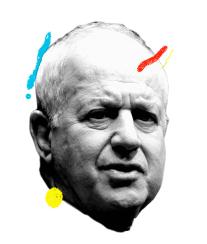
Illustrations: Lisk Feng; Photograph: Jin Lee/Bloomberg
In the early 2000s, Jules Kroll, then CEO of the eponymous security firm he founded, was working with investment bankers on his company’s first rating. When the credit-rating agencies were set to determine what score the company would merit, the bankers told Kroll he’d be asked ten questions and prepped him on what he should say in response.
He says the bankers told him, “‘They won’t have a deep understanding of your business. Here’s your script.’”
Sure enough, Kroll says he had a superficial conversation with analysts from the major agencies, and within two days the company had its rating. “This is a heck of a racket,” Kroll remembers thinking.
That revelation gave Kroll his next major business idea: to start a ratings agency where the ratings would be paid for by investors, rather than the companies being rated, to give markets “the straight story,” as he put it to Institutional Investor in a recent phone interview. “I saw right away the inherent conflict of having issuers pay for their own ratings.”
He sold Kroll Inc. in 2004 for $1.9 billion, but didn't retire until 2008. Casting around for a new business idea, he recalled his earlier experience with ratings agencies. He couldn’t help thinking that a new agency based on a model that eradicated this central conflict and offered impeccable due diligence would have a receptive audience — so he came out of retirement a few years later to do it.
His timing proved fortuitous. In 2008, Lehman Brothers’ bankruptcy filing set the financial crisis in motion, and it didn’t take long for the world to realize that the big three ratings agencies — Standard & Poor’s (now S&P Global Ratings), Moody’s Investors Service, and Fitch Ratings — and a handful of others had played a starring role in the fiasco.
That’s because these ratings have long been shorthand for a security’s value and ultimately determined the worth of the myriad credit securities that had proliferated on bank balance sheets and in investors’ portfolios. But instead of doing true due diligence on these securities, the agencies had rubber-stamped their highest ratings onto many of the toxic structured credit instruments that nearly took down the global financial system.
Kroll thought it was the right time to challenge the dominance of the big three. By the beginning of 2009, Kroll and RiskMetrics Group, which he had recruited for the venture, partnered and started doing the legwork for a new credit-rating agency.
“We were going to change the model,” Kroll says.
They could not have known how difficult — if not impossible — that would turn out to be.
This is not to say Kroll’s firm, Kroll Bond Rating Agency, hasn’t been successful. It grew gross fees by 49 percent annualized between 2012 and the end of 2017 on the back of growing institutional demand for alternative investments. Since 2011 it has rated 11,920 transactions, representing $785 billion and 1,500 issuers.
Still, KBRA and other competitors, including Lisbon-based ARC Ratings and Morningstar Credit Ratings, that have entered the sector in the last decade have barely made a dent in the market share of the big three.
The upstarts are facing more than just deeply entrenched competition, although that is striking: S&P, Moody’s, and Fitch control more than 90 percent of the market combined. A host of other complex factors have combined to make it nearly impossible to dislodge the big three — and to address the central conflict of interest baked into the ratings agency business model.
One of the biggest challenges — the very thing Kroll had set out to do differently — was figuring out who would be willing to foot the bill for ratings. As Kroll learned, it was easy enough to say the companies or other entities issuing securities shouldn’t do it, for the obvious conflicts that well-established model presented. What he hadn’t realized was that finding anyone else to pay for the ratings is virtually impossible.
At first, Kroll thought investors should be the ones to pay. But as KBRA president and CEO Jim Nadler points out, this poses its own issues. Investors who are short a security may want negative research published, for instance, while bullish investors may push for a positive report. Another problem: Investors are cheap.
“We didn’t find a single investment firm that was willing to pay for what they were getting for free,” says Kroll. The upshot was that KBRA ultimately settled on the exact same model that it had criticized: having the issuers pay for the ratings.
Regulators, too, have inadvertently slowed down new firms’ ability to gain traction. Since the crisis, regulators haven’t been in a hurry to approve inexperienced startups.
Perhaps the biggest obstacle of all is that the big three ratings agencies are thoroughly embedded in the plumbing of a global financial system that will have to be changed for new entrants to truly gain a toehold. For starters, pension funds, endowments, asset managers, and others are governed by investment policies, written decades ago, that often preclude them from owning any fixed income securities not rated by the big three. Such policies are a remnant from the days when S&P and Moody’s, in particular, were synonymous with credit ratings, and while this is slowly changing, those policies persist.
The California Public Employees’ Retirement System’s 2009 lawsuit against Fitch, S&P, and Moody’s over losses from subprime-mortgage-related securities the agencies had rated highly illustrates the industry’s inertia. Though the California pension won settlements from S&P and Moody’s, it required the two agencies to rate everything — even as it sued them.
Given these roadblocks, disrupting this business wasn’t going to be easy, even with the industry eager for new options.
But as his competitors soon learned, Kroll is not one to bet against.

The crisis gave him an entry point. People’s faith in the financial system had been broken by subprime loans and the alphabet soup of ultimately worthless securities tied to them — MBSs, CDOs, and so on — to say nothing of the $700 billion government kitty used to bail out bankers. He doubted that investors, banks, insurance companies, asset managers, international central banks, and the sovereign funds of countries around the world would return in force to do business with institutions they no longer trusted, and he thought he could rebuild that trust.
When RiskMetrics began talking to potential buyers in 2009, Kroll continued on his own. One of his selling points was that institutions would now want to know a lot more than whether a credit investment was worthy of a triple-A (high) or BB (low) rating, even if the existing agencies implemented radical reforms in the years ahead.
Instead of focusing on ratings, Kroll wanted to distinguish his business with the underlying research — which would be forward-looking and qualitative, not based on static models, and free to investors — as well as by breaking into new sectors and doing a more thorough evaluation of the underlying securities in structured products.
Investors, he thought, would welcome a new source of independent analysis, particularly at a time when few could afford to hire more people. Once investors were hooked on its in-depth research, they would push issuers to use KBRA for ratings, he reasoned.
In the fall of 2009, Kroll met with Nadler to talk about his idea for a “credit-rating agency on steroids.” Nadler, then an asset management executive at General Re, thought a new launch — with Kroll’s backing — could work, given the still-simmering anger after the crisis. But he hesitated.
“I knew what an undertaking it was,” Nadler said during an interview at KBRA’s midtown Manhattan offices as the company was preparing to move to bigger quarters. That’s because he'd been involved in building a ratings agency once before. In 1989, when Fitch was recapitalized, he joined to oversee structured finance.
Nadler got back in touch in the spring of 2010, though, when Kroll was looking for a president. “I couldn’t get the idea out of my mind,” he says. Nadler joined KBRA as a co-founder that June.
That summer they went out and raised money from family offices, venture capital funds, and individuals including value investor Michael Price, venture capitalist Frederick Adler, and real estate investor William Mack. Bessemer Venture Partners, RRE Ventures, New Markets Venture Partners, and Wharf Street also invested. (Wharf Street went from a minority to a majority investor in late 2015 and now owns about 90 percent of the firm.) Kroll and Nadler put their own money in the startup as well.
Although backers were intrigued by the idea of a new ratings agency, they also were making a big bet on Kroll himself.
“If I was brutally honest, I would say we raised the money partially on Jules’s reputation,” says Nadler.
Turning Kroll’s lofty talk about trust into a business took time.
“We were the first to view that the research is a big part of our product, not just the ratings. Investors want to know how we got to the conclusion,” Nadler says.
Nadler had learned some lessons from his days at Fitch, saying that the agency sold its service as an alternative to Moody’s and S&P and their lack of responsiveness to the market. “Fitch was going to do things better,” he says. But he says Fitch was trying to be disruptive at a time when there was no crisis in the background and investors had no pressing need to try something new.
“In the end, Fitch wanted to be like Moody’s and S&P. And they did it — they’re just like them,” he says. “I don’t have an aspiration to be like those three. I have an aspiration to change the relationship between investors and ratings agencies.”
Even though the scandals made an opening for new competitors, breaking into the business has still been a long slog.
Ira Powell, KBRA’s chief operating officer, who joined three and a half years ago from Goldman Sachs and who worked at Fitch in the mid-1990s after a short legal career, says dated investment policies have shielded the big three raters from paying a business penalty for their role in the financial crisis.
A senior executive at a state pension fund says it might be hard to believe, but trustees and others often nix any changes because they still think the ratings agencies whose names they recognize will keep them out of trouble. There’s little upside in adding a newbie, he says.
“That’s where I scratch my head,” says Powell. “You can’t dispute that the ratings agencies were complicit in the financial crisis, yet investors are still requiring them to rate deals.”
Patrick Early, head of fixed income research at Wells Fargo Advisors, explains that documents, such as statements, provide details about customers’ holdings, including their ratings from the major agencies. Adding a new one is not always easy. “It takes a lot to turn the ship,” he says.
To reach investors, KBRA also needs outlets like Bloomberg and Reuters to put its ratings on their terminals. Bloomberg carries KBRA’s structured finance ratings, and it took two years to get Bloomberg to add municipal bonds to one of its screens. KBRA is still waiting to get ratings for financial institutions and corporates added.
Regulators, even though they had been charged with encouraging more competition, also needed more time to approve new agencies after the crisis. It was taking so long to get a license to operate that KBRA decided to buy an existing agency, Lace Financial, and use its credentials to enter the business.
Things are slowly changing. “It used to be, especially in munis [municipal bonds], that you’d only see two ratings, Moody’s and S&P, and there weren’t a lot of single-rated issues,” says Wells Fargo’s Early. Now the market is more willing to take one rating rather than two, and if an issuer wants two, it will take one big agency and a new competitor, he explains. “I’ve tried to support the newer agencies. I try to leverage one against the other to see the different approaches.”
Still, “It’s an oligopoly. They had a head start of decades,” says Powell, whose mandate has been to institutionalize the scrappy startup. “They had gotten into the plumbing, into settlement systems, on data distribution sites. While we’re building up credibility as experts in the field, we’re also distracted by these infrastructure challenges and worrying about our ratings getting out to investors.”
An inherent problem at the core of the ratings business is incentives. And, as KBRA’s experience shows, even the scrappiest of upstarts haven’t truly solved this problem.

Kroll was passionate about having investors, rather than issuers, pay for ratings to eliminate this conflict. Egan-Jones Ratings Co., a boutique ratings agency whose clients are largely hedge funds and private equity firms, charges investors for ratings, and to Kroll that seemed like the obvious path to take.
But that plan was jettisoned early. Even knowing what happened in the crisis, investors wouldn’t pay. The problem was clear; how to solve it was not.
Nadler says investor-pay models present their own problems. In addition to the fact that investors may have their own motivations for having ratings go a certain way, regulators require ratings — not research — to be freely available. Few investors would allow competitors to free ride on the ratings they’ve paid for, he says.
Alice Rivlin, a senior fellow at the Brookings Institution think tank, former vice-chair of the Federal Reserve Board, and one of the authors of a 2017 report called “Credit Rating Agency Reform Is Incomplete,” says that in the years leading up to the crisis, issuers wanted high ratings, and agencies wanted to give them high ratings so they would come back and pay them more money for more business.
“Could that happen again? Under pressure would the system function differently?” she asks. “There is no real reason to think it would be different, because the basic problem is the issuer-pays model has perverse incentives. And nothing has changed that. No one had any terribly good ideas on how to change it.”
There are ways to remove conflicts, including rotating agencies on deals and setting up a government-sponsored agency. But both options pose their own issues and are difficult to implement.
Rotating issues among different agencies, part of a proposed amendment to the 2010 Dodd-Frank Act — the landmark legislation passed in the wake of the crisis — that never made it into the final legislation, also eliminates any incentive to do thorough research because ratings agencies would get a set share of work regardless of quality, says Nadler.
One thing Rivlin is sure of, though, is that issuer-pay is the heart of the ratings problem. New competitors won’t solve that, she says.
And they haven’t. In the end — just like S&P, Moody’s, Fitch, DBRS, and others — KBRA settled on an issuer-pay model. It planned to manage potential conflicts by being clear and transparent about its methodology.
It also wants to leverage investors’ skepticism of ratings. Large investors like BlackRock and PIMCO could afford to expand their in-house research and also add new independent firms. Smaller firms would likely opt to use third-party sources. This was KBRA’s entrée into the business.
Still, S&P, Moody’s, and Fitch are ubiquitous. KBRA chose carefully where it wanted to compete with the big guys. It was an easy decision to go after residential mortgage-backed securities first, as that was ground zero for the financial crisis. But after a build-out of RMBS offerings, KBRA faced a market that was still broken from the crisis. It then went after commercial MBSs and issued its first rating in 2011. It issued a total of six ratings that year.
With a lock on the industry, the ratings agencies didn’t always offer what customers wanted. KBRA wanted to target areas that the big three had never bothered with, such as regional and community banks. KBRA also decided to hire more experienced analysts and create more lucid and to-the-point reports.
The startup also made its research free for investors. “We wanted to be investor-friendly,” says Kate Kennedy, another Fitch veteran who is now in charge of investor relations and marketing for KBRA. “When I started at Fitch, all research was free! I kicked and screamed when they started subscriptions,” she says. “I said, 'If we want investors to rely on us, and tell issuers that they should use us, then we can’t charge investors for a report that we just got paid to write by the issuer.'”
KBRA dug deeper into securities such as CMBSs, which are pools of commercial mortgages. Instead of analyzing and doing site visits on the top ten properties in a deal, which was standard practice, KBRA would do a walk-around of approximately 70 percent of the pool of loans that backed the deal.
Investors are noticing. “KBRA has a team of battle-tested analysts who have been through all types of market cycles — both good and bad,” says Stephen Winterstein, managing director of research and head of municipal strategy at Wilmington Trust Investment Advisors.
KBRA’s competitors are noticing too. S&P, Moody’s, and Fitch have since started their own versions of some of the startup’s offerings.
“The firm has been bringing new products to market in response to competitors and market demand,” acknowledges Chris Heusler, global chief commercial officer at S&P Global Ratings. That includes new coverage such as an infrastructure group it added in 2015, the first new practice in 15 years. “We want to remain relevant.”
But he adds that while S&P says it supports competitors, it has a dominant position because it has a long track record with investors. S&P has 1,400 analysts who cover more than 1 million securities.
A Moody’s spokesman says, “We believe that strong demand from market participants reflects the extensive scope of Moody’s credit ratings coverage and the quality of our analytical insight. Moody’s published more than 29,000 reports and in-depth sector research last year alone, and we continuously strive to expand and enhance our ratings and research to reflect evolving market needs.”
Fitch didn’t make executives available to comment by press time.
Of course, some competition was to be expected, especially after the financial crisis. Provisions in the 2010 Dodd-Frank Act pushed to remove all specific references to ratings agencies from federal guidelines, in an attempt to create a more competitive landscape in the U.S. The thinking at the time was that more competitors would be better for the industry, as new entrants would introduce different business strategies and ratings models.
Robert Pozen, a senior lecturer at the MIT Sloan School of Management and author of Too Big to Save? How to Fix the U.S. Financial System, says a lot of people don’t really want the model to change.
“Most big investors are averse to paying; they do their own credit research and they trade on the differences with the ratings agencies,” he says. “Weirdly, if they think the credit-rating agencies are off, that’s good for them.” Individual investors and small asset managers are the ones who need accurate ratings. But their voices aren’t being heard because they aren’t well organized and aren’t big enough bond buyers, argues Pozen.
Pozen adds that credit-rating agencies are also damned if they do and damned if they don’t. To wit: the controversy that ensued after ratings agencies downgraded the U.S. “They raised the issue of credit ratings in certain sovereigns in Europe, and the sovereigns went nuts,” he says.
Still, KBRA, which now has 320 employees, is pressing on. It’s been approved by the Department of Labor, so funds regulated under the Employee Retirement Income Security Act, or ERISA, can invest in KBRA-rated structured finance transactions. And it recently got the green light to offer structured finance ratings in Canada. The European Securities and Markets Authority approved KBRA and the firm, which recently opened an office in Dublin, is slowly breaking in.
KBRA is now trying its hand at rating corporate bonds, which may represent its biggest challenge. Corporates represent 50 percent of the ratings market, but often require only one rating. And it’s not transaction-based like structured credit, where issuers can try KBRA and see how it goes. The firm is starting with junk bonds, riskier investments where it believes quality information is critical.
Still, S&P Global earned $2.99 billion in ratings revenue last year, up 18 percent from 2016. Moody’s Investors Service reported record revenue of $2.8 billion, up 17 percent from 2016. Meanwhile, KBRA hit $93 million in revenue last year.
But Kroll says his firm should not be counted out.
“In five years we will be one of the big four,” he declares. “There will be Moody’s, S&P, Fitch — and ourselves.”





